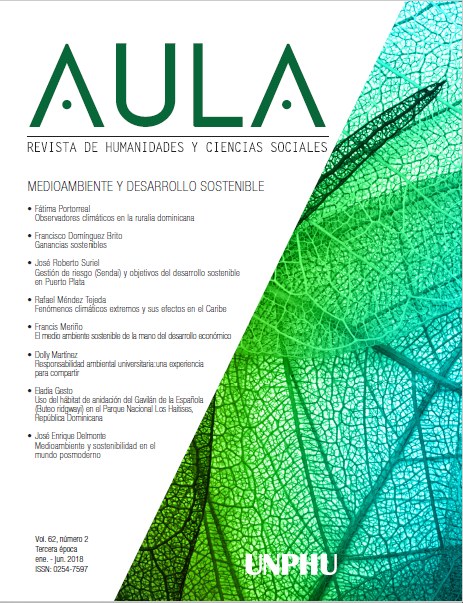Use of nesting habitat for the Ridgway’s Hawk (Buteo ridgwayi) in Los Haitises National Park Dominican Republic.
Published 2018-09-13 — Updated on 2023-06-01
Versions
- 2023-06-01 (2)
- 2018-09-13 (1)
Keywords
- Ridgway’s hawk of Hispaniola,
- Buteo ridgwayi,
- habitat,
- endemic birds,
- National Park
- nesting ...More
How to Cite
Copyright (c) 2018 AULA Revista de Humanidades y Ciencias Sociales

This work is licensed under a Creative Commons Attribution 4.0 International License.
Abstract
The Ridgway’s Hawk (Buteo ridgwayi) is an endemic raptor to the Hispaniola, considered the most threatened bird in Dominican Republic and one of the most endangered raptors of the world, with an historical distribution of 27 spots in the island reduced its population to one only remaining habitat Los Haitises National Park. The establishment of nesting habitat patterns for this bird is an important data for the understanding of its environmental preferences as vulnerable population, in order to be useful for the decision taking in conservation actions for the specie. For determining the habitat use patterns of the Buteo ridgwayi, 186 trees were sampled. Measures of dasometric variables and
vegetation coverture were taken. For the estimation of landscape patterns in a fragmented and deforested environment, landscape metrics in a 250 mt of buffer area and the home range area was calculated.
For the selection of the nesting tree species by the Buteo ridgwayi, the variables height and spp presented the higher relevance for the bird. The nesting tree of preference was Roystonea borinquena with 81% of the nesting cases. The land use Scrubland had the majority of the cases of nesting with 43% of the cases. The nests of Buteo ridgwayi had lower values for the metric nearest neighbor distance in comparison with other species of the genus Buteo. The proximity in distance between nests indicates of the scarcity of adequate conditions in the environment of this population under monitoring. The nest of Buteo ridgwayi were located in different land uses in fragmented and deforested
areas showing there is not a direct dependence with the forest for nesting.
Â
Downloads
References
- Andren, H. (1994). Effects of Habitat Fragmentation on Birds and Mammals in Landscapes with Different Proportions of Suitable Habitat: A Review. [ Efectos de la fragmentación del hábitat en aves y mamíferos en el paisaje con diferentes proporciones de hábitat adecuado]. Oikos, 71(3), 355-366. https://doi.org/10.2307/3545823

